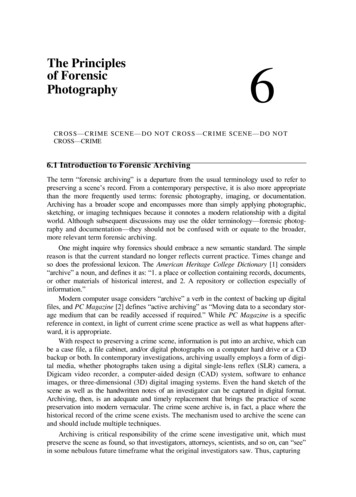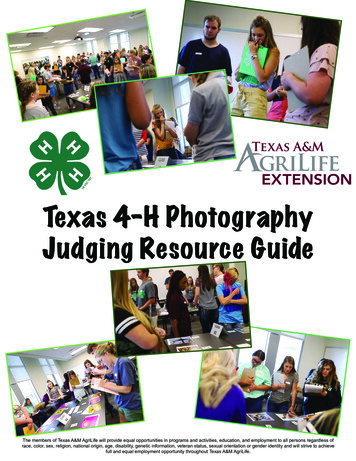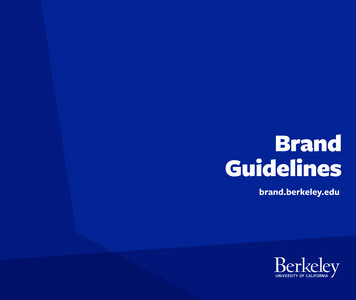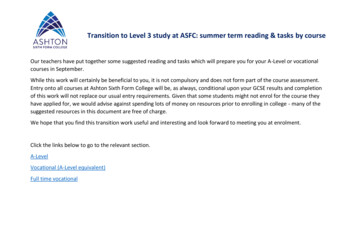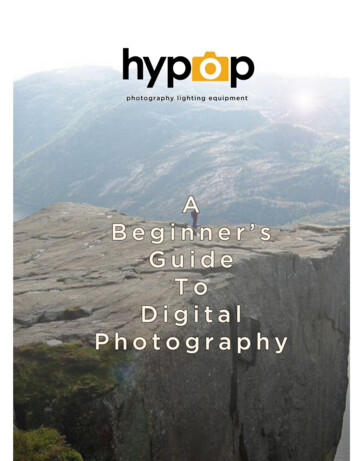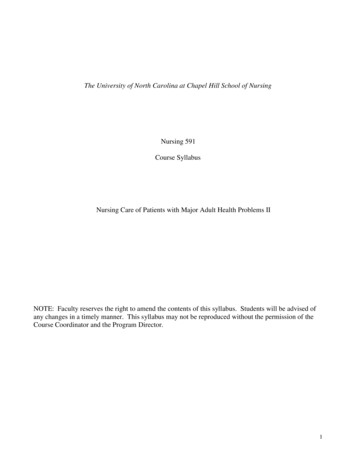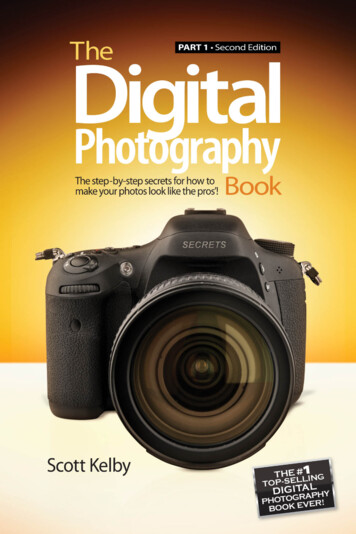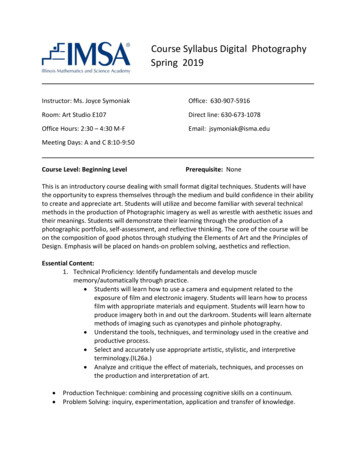
Transcription
Course Syllabus Digital PhotographySpring 2019Instructor: Ms. Joyce SymoniakOffice: 630-907-5916Room: Art Studio E107Direct line: 630-673-1078Office Hours: 2:30 – 4:30 M-FEmail: jsymoniak@isma.eduMeeting Days: A and C 8:10-9:50Course Level: Beginning LevelPrerequisite: NoneThis is an introductory course dealing with small format digital techniques. Students will havethe opportunity to express themselves through the medium and build confidence in their abilityto create and appreciate art. Students will utilize and become familiar with several technicalmethods in the production of Photographic imagery as well as wrestle with aesthetic issues andtheir meanings. Students will demonstrate their learning through the production of aphotographic portfolio, self-assessment, and reflective thinking. The core of the course will beon the composition of good photos through studying the Elements of Art and the Principles ofDesign. Emphasis will be placed on hands-on problem solving, aesthetics and reflection.Essential Content:1. Technical Proficiency: Identify fundamentals and develop musclememory/automatically through practice. Students will learn how to use a camera and equipment related to theexposure of film and electronic imagery. Students will learn how to processfilm with appropriate materials and equipment. Students will learn how toproduce imagery both in and out the darkroom. Students will learn alternatemethods of imaging such as cyanotypes and pinhole photography. Understand the tools, techniques, and terminology used in the creative andproductive process. Select and accurately use appropriate artistic, stylistic, and interpretiveterminology.(IL26a.) Analyze and critique the effect of materials, techniques, and processes onthe production and interpretation of art. Production Technique: combining and processing cognitive skills on a continuum.Problem Solving: inquiry, experimentation, application and transfer of knowledge.
Collaborative Learning: Teamwork and leadership opportunities within the parametersof an ethical frameworkAesthetic Development: Explore creativity through the interconnections of culture,design, and historical genreAesthetic Appreciation/Lifelong learning: magnify personal perception of beauty,meaning, value, intent, & emotional contentAesthetic Experience: Synthesize the identified core elements into the resultantproduct. Standards: Artistic Process: Creating: Conceiving and developing new artistic ideas and work. Artistic Process: Presenting: Interpreting and sharing artistic work. Artistic Process: Responding: Understanding and evaluating how the arts conveymeaning. Artistic Process: Connecting: Relating artistic ideas and work with personal meaning andexternal context.Objectives: Develop automaticity in skills, concepts & processes that support and enable complexthought. Developing muscle memory and repetition in order to fabricate a piece of art. Use appropriate technologies as extensions of the mind. Selecting equipment & tools that will allow for creative endeavors. Recognize, pursue, and explain substantive connections within and among areas ofknowledge; having the ability to recognize connections between the arts and othercontent-based curricula and cultural relationships to extend understanding and lifelonglearning. Recreate the “beautiful conceptions” that give coherence to structures of thought. Visual thought structure which results in the beautiful conception continuum or anaesthetic experience through experimentation & exploration of the arts.Text(s) / Materials: Students will receive a series of teacher generated handouts andworksheets. Supply fee may be required.Instruction Design and Approach: Opportunities to produce solutions to design problems Production of artwork or artifacts. Lecture presentations, demonstrations, & critiques.
Learning GroupsStudents will work individually* on most projects, collaborating in small groups at times forformative assessments and in class groups for critiques.The creation of artwork is problem centered. Students will explore individual approaches tomaterials,procedures, technology, ideology, iconography, & historical/cultural associationsto create their original artworks.STUDENT EXPECTATIONSAttendance:Students must make up all missed work. Numerous absences will diminish a grade.Late work, Academic & Personal Integrity: Hand in your work on time. One letter-grade reduction or a 10% grade reduction per dayfor all assignments. Always hand in original work. If you are caught plagiarizing, you will be referred to theDean of Students. Students are always expected to behave respectfully and appropriately. Otherwise,dismissal from classroom.Clothing: Please wear shoes (not sandals). Keep purses and book bags on the floor - please do not ‘wear’ them. Please wear clothing that allows you to work freely, without concern for art materialsthat may get on your clothing. Please wear shirts or tops and pants that do not reveal undergarments.Respect for Supplies: Always respect the tools we use in the process of making art - this includes conservingsupplies. Always leave the art supplies in the art room unless you are given a 'take-out' pack forhomework. Students will be held financially accountable for broken, lost, or misused supplies andequipment.Safety and Sensory issues:Creating art can pose sensory and safety issues. If there are situations in class where safety is aconcern, instructor will instruct you how to deal with these in a safe manner. If you have anysensory issues with a project procedure, you must let me know immediately.Clean-up:
We are a community and as such, should always be willing to clean up the area both foryourself and others when they need assistance.Assessment Philosophy:Because this is a studio course in which production aesthetic awareness and capacity is theemphasis, assessment will be based upon a number of related factors. These factors include: Ability to follow instructions and meet deadlines. Ability to complete projects/assignments Tenacity (work ethic) Issues relating to craftsmanship Issues relating to creativity, aesthetics, and artistic originality Ability to work safely and clean up after oneself and pitch in with generalstudio cleanup Ability to self-reflect on one’s own performance and/artwork Ability to conserve and recycle Ability to use and recognize appropriate terminology and procedures Issues relating to attendance and ethical behavior Ability to discuss artwork as it reflects aesthetics and social significancePre-Assessments:Most units will begin with a Pre-Assessment to determine unit content.Formative Assessments:Methods: One-on-one conversations Small group conversation Individual or group critiquesSummative Assessments:Summative Assessments will be given at the end of each unit or project using numerical gradesin PowerSchool Some exams or quizzes Creative ‘artifacts’ produced by the student (assessments based upon specific criteriagiven to students at the beginning of each unit. Student will submit their own gradedrubric along with their project.) Student will keep all their artwork/artifacts related to the course. This will be in digitalformat via an electronic portfolio.GRADE SCALE:A 100-94% A- 93-90%B 89-86% B 85-83% B- 82-80%C 79-76% C 75-73% C- 72-70% D 69%
INSTRUCTIONAL STRATEGIES: (see below)DemonstrationsLecturesCritiquesGRADING CRITERIA: Grades for the course will be determined in the following manner:50%: Classroom/Group Participation Portfolio Presentation Studio Projectso Concepts/objectives have been meto Completion of projecto Creativity, originalityo Proper craftsmanshipo Developing manual and technical skillso Developing perceptual skillso Class Participationo Daily work habits Care of supplies and equipmento Time on tasko Group interactiono Studio interactiono Studio activities participationo Attendance and promptnesso Preparation for class (materials)o Cooperation30%: Test, Quizzes, Individual Assessments Homework20%: Written Components Class critiques Research Self-evaluations Vocabulary Written critiques Exams Oral presentations ResearchWeek 1: Introduction to course, understanding materials and equipment. History ofphotography unit and advancements, research paper on; advancements into the world oftechnology. (How did technology change and how art change technology, what was the impactof each?) Project One, getting to know your camera. Learning about equipment and gettingassigned teams, cameras and computers.
Week 2: Project 2 and 3. Project 2 will be done outside of class, for the written research isimportant to the understanding photography and the artists behind the lens. Length of UnitIntroduction to digital art and photography, learning about the movement from box cameras todigital. Project 3 is based upon how the student will learn to view images. Using photographyand printmaking.Week 3: Developing a field study of subject matter. Learning Rule of Thirds and computerbased editing. Understanding color theory in photography and how it impacts your images.Homework includes completing a color wheel and using color theory for project 4.Week 4: Understanding of photo papers, combining photography and technology.Understanding the benefits of and draw backs of both. Learning about Photoshop and how touse it correctly to enhance colors and crop images correctly. Working in teams to sharecomputers along with completing homework. Students may use computers in the library tocomplete homework and work on cropping images.Week 5: Projects creating collage of photography in Photoshop, scanning and moving images,further understanding of technology in Photography. Starting to explore ISO and how to useyour camera to its fullest. After this week images will no longer be set for automatic, studentswill be asked to use metadata and ISO settings on all images. (Combining projects 2-4 to createmore images.)Week 6: Learning about the camera, ISO, Apertures, F stops. Project 6, working with variedaperture settings and adjusting your ISO to create images of motion and movements. Usemetadata to record all settings, adding dates and times.Week 7: Lightroom and how the process works. Working on freezing action, project 7. Using Fstops and adding the learned information with ISO settings and aperture settings to furtheryour understanding of your camera. Homework will include research of setting up motion,taking images will involve out of school work.Week 8: Introduction into taking portraits. This will involve learning how to get candidmoments, and then following through with model release and the importance of such releases.Such candid moments will then be brought into Photoshop for minor corrections, of light andbalance.Week 9: Themed digital works, research into photographer of choice. Creating similarprojections. Starting in studio setups and lighting. Abstracts through the eyes of thephotographer will be reviewed and students will start to gain understanding of the importanceof photography. Science study of flowers and the abstraction, bisection of such will be studied.Project 9 will be started for this better understanding of the importance of knowing how to useISO.Week 10: Project work and open studio time
Week 11: Creating an E-portfolio. How to create one and its importance. Work on physicalportfolio in order to gain understanding of how to achieve a good portfolio and why it isimportant to have one, even in the sciences.Week 12: Putting all the stages together. Understanding how all processes work together.Continued studio work taking images of food, and the importance of timing. Changing upstudio setups and the effects of such changes can affect your images for the best possiblelighting effects. Photo enhancement is not allowed for Project 12.Week 13: Using multimedia techniques in understanding complex forms within a portrait andstill life photography. How a photographer could combine different studio effects, ISO, F- stopsand lighting effects to create pleasing images without using technology, students will followdirections on combining ideas in Project 13 and 14.Week 14: Development of a portfolio, revisiting the importance of field studies.Week 15: Working towards portfolio completion and final presentations.Week 16: Final Project and portfoliosWeek 17: Presentation Design, Final presentations.Complete Calendars will be given out during week 2. Teacher has the right the make changesto projects and to calendars.CHEATING & PLAGERISM Cheating is the act of obtaining or attempting to obtain credit for work by the use of dishonest,deceptive, or fraudulent means. Plagiarism is the act of taking ideas, words or specific substance of another and offering them as one’sown.Cheating, plagiarism, and falsification of student work, including documents will be submitted to KatieBerger for review.
Digital PhotographySpring 2019Instructor: Ms Joyce SymoniakTelephone: 630-673-1078Room: Art Studio E107Email: jsymoniak@isma.eduOffice Hours: 2:30 – 4:30 M-FMeeting Days TBAAGREEMENT(please sign and return to the instructor)I have received, read, and understand the course syllabus for Digital PhotographyThe instructor has, within the structure of the class, explained the material contained within thesyllabus.Student Signature:Printed Name:Contact Information (please print clearly):e-mail address:Alternate e-mail:Cell phone number:
important to the understanding photography and the artists behind the lens. Length of Unit Introduction to digital art and photography, learning about the movement from box cameras to digital. Project 3 is based upon how the student will learn to view images. Using photography and printmakin


